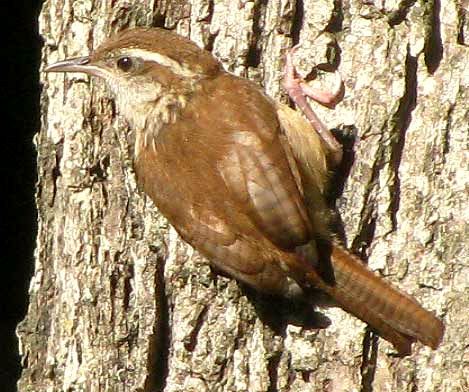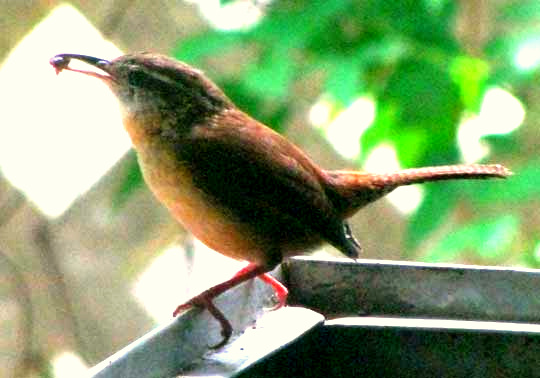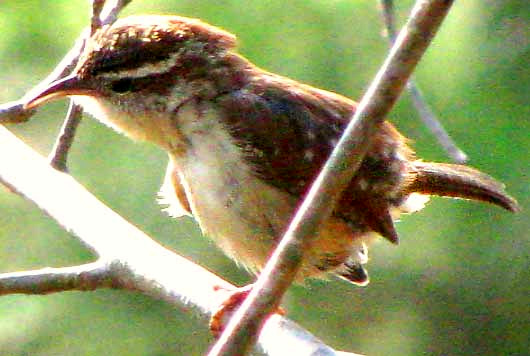Excerpts from Jim Conrad's
Naturalist Newsletter
from the May 13, 2012 Newsletter, issued from the forest near Natchez, Mississippi; elevation ~400ft (120m), ~N31.47°, ~W91.29°:
WREN PORTRAIT
While the camera was set up photographing the woodpeckers a Carolina Wren suddenly flew onto the trunk and presented the nice portrait shown below:

It's nice to see the extent of barring on the tail and wings, and surprising that the wing feathers display such whiteness.
from the April 22, 2012 Newsletter, issued from the forest near Natchez, Mississippi; elevation ~400ft (120m), ~N31.47°, ~W91.29°:
WREN WITH A BUG
For a couple of weeks a pair of Carolina Wrens has been feeding their nestlings beneath a nearby shed's eaves, and before they glide into the nest they pause right outside my window, look around, then proceed. You can see one carrying what looks like a fly below:

When this happens I'm reminded of the classic Haiku by Issa:
That wren--
Looking here, looking there.
You lose something?
from the February 23, 2009 Newsletter, issued from the forest near Natchez, Mississippi; elevation ~400ft (120m), ~N31.47°, ~W91.29°:
THIS YEAR'S CAROLINA WREN
All during my hermit years Carolina Wrens, THRYOTHORUS LUDOVICIANUS, nested in my outside kitchen, in the barn I stayed in on Sandy Creek and here and there wherever I took walks, especially in and around abandoned and semi-abandoned buildings. Though they can be as wary of humans as any wild bird, my impression is that individual Carolina Wrens deciding that humans aren't dangerous may actually prefer nesting near often-used doors and walkways. The one living in the box strapped to the overhanging porch- roof above my campfire clearly has defined my trailer as the center of his living space.
Each afternoon at around 5:30 as light begins fading he comes examining as if for the first time corners, fallen twigs, cracks in walls, and such, and sometimes lands on a broom handle or porch step actually seeming to pose to give me a good look. He's so fast, though, and my camera has to whir and accomplish so many adjustments, that I never get a great shop, just blurs and shots of where he'd been half a second earlier. The other day I did get a halfway passable shot of him when he paused to scratch himself, and that shot is shown below:

When I was a kid on the farm in Kentucky we called this species House Wren because they habitually built in any birdbox or anything close to a birdbox that people put up. Later I learned that there was another bird more correctly called House Wren, a less common one without the conspicuous white eyebrow and not so much rusty-reddishness on the back. In eastern North America the only other wren halfway looking like it is the Bewick's, which is mostly a western species. However, Bewick's usually are not so reddish on the back and their tails bear conspicuous white spots.
Though Carolina Wrens are mainly southeastern North American birds the species is so adaptable that it's steadily expanding both northward and westward. It's already well established in southern Ontario and central New York, and seems set to expand to well north of the Great Lakes. That's OK with me, for this friendly little bird can make anyplace feel more like home.
from the July 22, 2001 Newsletter, issued from near Natchez, Mississippi:
WRENS NESTING
Each summer a pair of Carolina Wrens nests near my trailer. Usually during the days leading up to their building their nest I must constantly be shooing them away from leaving straw in my fireplace, my laundry bag, my popcorn bag hanging from the ceiling, the pockets of my hung-up coat, etc. This year I nailed a small, overturned bucket near a corner and eventually they raised their first brood of the year in it.
Some weeks ago I discovered them nesting in my open-walled toilet, in a cardboard-cylinder-thing I'd mounted on the wall, in which to store my toilet paper so the White-footed Mice wouldn't carry all my paper away to their nests. I didn't like this choice, but what can you do? Each morning lately I would peep into the nest and see the mother Carolina Wren patiently brooding.
Today the wrens are out foraging and there's no sign of the young. I assume that this is the consequence of a certain handsome, red-blotched Corn Snake, called Chicken Snake by some folks, that habitually drapes itself here and there in and around the toilet during my presence. I'm glad for the snake to be there, for it works hard to keep down the mouse population -- which carry ticks, which carry Lyme Disease, which we have here. And it's true that a Corn Snake will eat a nestling or two if it's handy.
Well, if all Carolina Wren nestlings lived, soon we'd be overflowing with them. Besides, the first brood seems to have survived, and the parents are already exploring my fireplace, popcorn bag and coat pockets for Brood #3.
from the June 2, 2002 Newsletter, issued from near Natchez, Mississippi:
THE WRENS' SECOND BROOD
Last Sunday the four eggs in this year's second nest of the Carolina Wrens who claim my camp all hatched just when they should have. The first brood, you will recall, was laid in my toilet.
Last Sunday I was astonished to see that as the parents brought this second brood their food, three fledglings of the first brood were still following the parents around. The fledglings weren't exactly begging for the insects the parents brought the new nestlings, but they certainly looked at their parents with wide-eyed expectation.
I had never seen parents feeding one nest while fledglings from an earlier nest still followed them. Have any of you seen such a thing?
from the February 3,, 2003 Newsletter, issued from near Natchez, Mississippi:
CAROLINA WRENS BEGINNING AGAIN
Despite the chilly weather this weekend, most of the week has been unseasonably warm and humid. Peas in my garden are growing like weeds and birds are getting frisky.
The most conspicuous among these hormone-saturated birds are the same two Carolina Wrens I've mentioned before dust-bathing in my kitchen where the doodlebugs congregate. While I'm sitting in my trailer working at the computer, right outside my screen door I hear a beseeching little squeaking sound, and its one of the wrens making ingratiatingly domestic sounds as the partner examines this or that spot as a potential nesting site. They nose about my fireplace, pots and pans, and snoop in every disreptable corner.
I've had to clean their nest-straw from my laundry bag, the plastic popcorn-bag hanging from the ceiling, and the pockets of a coat hanging from a nail. This will go on until they decide to nest in the box I've put up for them. It's always like this. They seem to hold my box in little esteem, building test-nests there but every other place as well, and then one morning the female will be in the box working on her first egg.
These wrens have been here as long as I have. As soon as I put up the kitchen they moved in as if they had every right to be there. I've lost count of the years I've been here -- four or five, I think. However, only last spring did I begin recognizing each bird as an individual with its own personality and it's own physical characteristics.
At that time the female was large and self assured but the male was small and nervous -- almost cowardly. Then one night as I was sleeping not far from where they were overnighting between broods, in a plastic jug I'd put up for them, I heard one of them screaming, and there was heavy thumping inside the jug. I figured the Black Racer snake that had been hanging around (and still is) had got himself a wren, and that was probably a good guess. The next morning as soon as there was light enough to fly the little male rushed from beneath my trailer issuing his emergency call, and the female was gone.. Each morning at dawn for about a week, for a good fifteen minutes, he did the same thing, his emergency call again and again, flitting from place to place looking, looking...
Then one day he came in with another female, one about his size, but this time he was the leader, and she was the timid one. They got a nest going in no time and soon everything was back to normal.
Now the female is about as large and self confident as the male, and they are both substantial birds, as far as Carolina Wrens go, substantial both in physical and behavioral terms. They are a good pair, and I think that they will put on a good show this season. I suspect that you will hear a lot more about them.
from the August 10, 2006 Newsletter, issued from near Natchez, Mississippi:
WRENS AGAIN
Longtime readers may recall that at my camps in Mississippi each summer Carolina Wrens built nests in my outside kitchen and barn-room office. A few weeks ago when I walked into the indoor kitchen here and saw a wren peeping into the wall hole where a stovepipe once entered I knew what was going on. This old house is missing so many windows and screens that birds, bats, butterflies and other critters pretty much go and come as they please, basically ignoring me.
For several days I kept shooing the bird away, fearing that if a nest got going Lucian the carpenter might clear it out, since I've heard talk of tearing the old chimney down. Then one day I peeped into the nest and saw four wren eggs, so I gave up.
When the mama wren hears me get up from the computer in the next room planning to get some water from the kitchen, usually she decides to avoid me by flying across the kitchen and out the next room's window. What this means is that typically we pass one another as I enter the door leading into the kitchen. She flies right past my head, sometimes her wing feathers brushing my ear. If I wait a few extra seconds to let her go first, she tends to wait a few seconds as well, so we meet the same way. If I rush, she rushes. So, it's worked out that we just expect to meet in that door, and then she squawks and complains as she exits the window.
Maybe it's the male who comes for a visit, lands in the middle of the floor, and sings as robustly as possible. Because there's no furniture, no curtains or anything except bare wooden floor and bare wooden walls and ceiling, it's like an echo chamber. It sounds like a six-foot bird woopidy-woopidy- woopidying. When you've been sitting a long time absorbed in computer work, that sudden, shrill outbreak of woopidying can surprise you.
The German name for a wren is "Zaunkönig," which means "King of the Fence." That name suggests a familiarity with the fussy little wren's manner going back many generations. I can just imagine my ancient Germanic- tribe ancestors smilingly shaking their heads at their own audacious, noisy little brown birds complaining at them from boulders and rock fences. "Zaunkönig!" they laugh, and spit.
from the August 26, 2001 Newsletter, issued from near Natchez, Mississippi:
WRENS & DOODLEBUGS
The Carolina Wrens with whom I share my outside kitchen spend at least half an hour each day, mostly in the late afternoons, dust bathing beneath my kitchen's tin roof. Sometimes with my binoculars I watch them simply because it's a pleasure seeing them enjoy themselves so much.
They do every kind of fluttering and flopping, creating round-bottomed pits in their favorite spots, but their most spectacular movement is when they fluff their feathers and with their feet hidden beneath them scoot across the dust like mechanical mice with frantically wagging tails. They rub their cheeks in the dust and sometimes lie on their sides with their bottom wings held so that plenty of dust reaches the tender spots beneath the wings. They usually bathe together and often after particularly long bouts of bathing one suddenly stops, and then the other stops, and they look at one another (I see them both panting from their exertions) and I wonder what they are thinking as each gazes at the other absurdly fluffed-out, exhausted and dusty creature.
All this has been hard on my doodlebugs. Before the wrens discovered my dust, the dust was the sole domain of about 30 of these little creatures which the books prefer to call antlions. Doodlebugs, or antlions, are the larvae, or immature stages, of an insect something like damselflies or lacewings, which are slender flying insects with delicate wings. Doodlebugs dig conical pits in the dust and hide themselves beneath their pits so that their jaws are open, inside the dust, exactly at the pits' bottoms. When an ant or other small insect stumbles into a pit, the doodlebug clamps its jaws upon a meal.
I know why I've always had a special fondness for doodlebugs. It's because my father taught me something about them, and my father was not a good one for teaching. My father taught me that if you get onto your hands and knees and put your face up close to the doodlebug pit and say "Doodlebug, doodlebug, your house is on fire," the doodlebug will knock dust in your face.
It really does this. It's because your breath dislodges particles into the pit, and the doodlebug automatically knocks the debris back out.
I'm amazed that I take such pleasure in having a doodlebug knock dust in my face. Doodlebugs have caused me to reflect on how easy it is for a father to please his son with such modest investments of time and energy. Parents in the human species have enormous powers, and responsibilities.
from the August 5, 2001 Newsletter, issued from near Natchez, Mississippi:
DUST BATHS
Each afternoon between 6 & 7 PM the Carolina Wrens I've mentioned before visit my outside kitchen to snoop around and peck at this and that. Lately the big female has discovered the joys of hopping beneath the grill holding my skillet, and dust-bathing in my woodfire ashes. She flutters with her eyes closed, lies on her side and stretches, clearly enjoying it all enormously, and when she's finished she is a truly gray wren hopping about with renewed vigor.
I've never seen a definite statement on why birds take dust baths, but most authorities agree that it probably has something to do with making life hard for parasites living among the birds' feathers, and sometimes there's a mention of the dust carrying away excess oil, and maybe of putting essential micronutrients in contact with the birds' skins. Actually a good bit of study has been done on dust bathing among egg-laying hens. If dust bathing could be shown to make hens produce more eggs, you can bet that dust trays would be furnished in every commercial henhouse.
However, no one has shown that hens really need to take dust baths, or that dust bathing increases egg-laying. On the other hand, it is clear that hens do want to bathe in dust. One study in Canada found that a significant percentage of hens would push harder on doors held in place by weights if they knew that dust awaited them on the other side.
from the June 13, 2004 Newsletter, issued from near Natchez, Mississippi:
THAT WREN
Just after dawn on Tuesday morning I realized that something was missing. For several days the Carolina Wrens had been carrying bugs to their second-hatched brood of the year. I'd grown accustomed to their perpetual flying in and out of the tool room across from my computer room in the barn. Tuesday morning all was quiet, so I knew that the nestlings had left their nest. In times past I've seen that once the nest is abandoned the whole family avoids me for a week or two.
However, in mid morning I heard a beseeching peep from inside the barn's garbage can. Inside was one of the nestlings barely keeping his head above the water pooled there after recent rains (leaky roof). I could imagine the whole sequence of events: One by one the nestlings had been coaxed to fly from their nest on the high shelf in the tool room and this one had made it out of the room as far as the trashcan's rim, but he'd bungled his first landing, tipping into the can. Once his feathers were wet he couldn't fly out. The family had gone on without him.
I dried him off and set him on the barn's cement floor outside my door where for a long time he just sat looking around. After an hour or so he began peeping and hopping about. Finally around noon one of the adults returned flying here and there. A plaintive peep, a sturdy reply, a flutter of wings upward, and within moments an open beak was plugged with a green grasshopper.
After a few more feedings both birds disappeared the way wrens are supposed to on the first day of fledging.